Complete Solutions to REVIEW QUESTIONS (Questions based on diagrams or set-up) of chapter TRANSPORT IN PLANTS of Class 11 book with complete answers and questions
| Class 11 | BIOLOGY |
| Chapter | TRANSPORT IN PLANTS |
| S CHAND | REVIEW QUESTIONS (Questions based on diagrams or set-up) |
| Number Of Questions | 30 |
| Academic Year | 2023-24 |
Study the set-up given alongside and answer the questions given below:

Which physiological process does this setup of experiment show?
View SolutionStudy the set-up given alongside and answer the questions given below:

What will happen to the level of water in test tubes A & B?
View SolutionStudy the set-up given alongside and answer the questions given below:

What will happen to the level of water in test tubes A & B?
View SolutionStudy the set-up given alongside and answer the questions given below:

Why is the surface of water covered with oil?
View SolutionStudy the set-up given alongside and answer the questions given below:

What is the purpose of the setting up test tube B?
View SolutionStudy the diagram given alongside showing a plant cell kept in a strong sugar solution.

Name the parts a, b, c, and d.
View SolutionStudy the diagram given alongside showing a plant cell kept in a strong sugar solution.

Which part of the cell acts as a semipermeable membrane?
View SolutionStudy the diagram given alongside showing a plant cell kept in a strong sugar solution.

Name the process the cell has undergone.
View SolutionStudy the diagram given alongside showing a plant cell kept in a strong sugar solution.

Name the process the cell has undergone. What is the reason of the process named?
View SolutionStudy the diagram given alongside showing a plant cell kept in a strong sugar solution.

What will happen to this cell if it is kept in water?
View SolutionStudy the set-up given in the diagram and answer the following questions:

Which limb of the set-up contains more concentrated solution?
View SolutionStudy the set-up given in the diagram and answer the following questions:

What will be the level in tube A and tube B after 1 hour of set-up?
View SolutionStudy the set-up given in the diagram and answer the following questions:
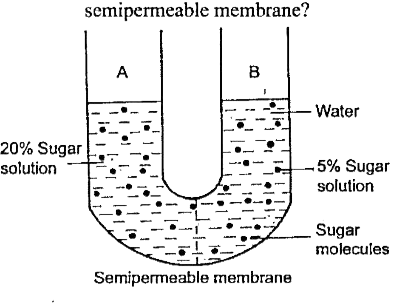
What is this process known as?
View SolutionStudy the set-up given in the diagram and answer the following questions:
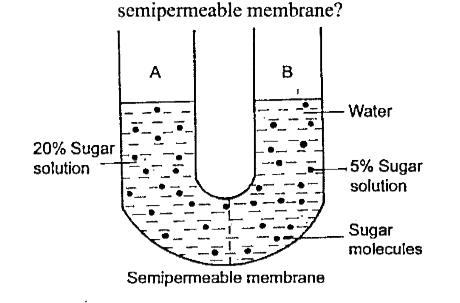
Why is the membrane called semipermeable membrane?
View SolutionStudy the set-up shown in the diagram and answer the following:

What change will you observe in part 'B' of the setup after one hour? Give reason for this change.
View SolutionStudy the set-up shown in the diagram and answer the following:
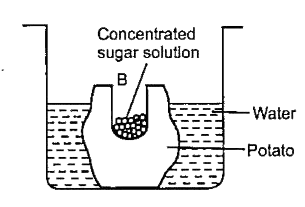
What is the technical term for this process?
View SolutionStudy the set-up shown in the diagram and answer the following:

What will happen if a boiled potato is taken?
View SolutionThe figure given below is a diagrammatic representation of a part of the cross-section of the root in the root hair zone. Study the same and then answer the questions that follow :
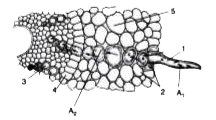
Name the parts indicated by guidelines '1' to '5'.
View SolutionThe figure given is a cross section of the root along with a root hair.-Study it and answer the questions given below:
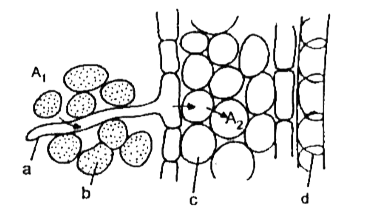
Name the process involved in flow of water from `A_(1)` to `A_(2)` .
View SolutionThe figure given is a cross section of the root along with a root hair.-Study it and answer the questions given below:
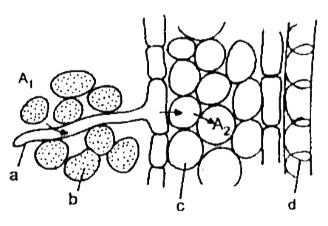
Mention two important features of part (a) that help it to absorb water.
View SolutionThe figure given is a cross section of the root along with a root hair.-Study it and answer the questions given below:

What is the function of part 'd' in a plant?
View SolutionStudy this structure of a root hair and answer the following:

Label parts a, b, c, d and e.
View SolutionStudy this structure of a root hair and answer the following:

What is the function of root hair?
View SolutionStudy this structure of a root hair and answer the following:

What is the function of root hair?
View SolutionStudy this structure of a root hair and answer the following:

Give one important property of part 'e'.
View SolutionStudy this structure of a root hair and answer the following:

How many cells is a root hair made up of?
View SolutionObserve the cell drawn and answer the following questions:

Label parts a, b, and c. If this cell is kept in a concentrated sugar solution., what will happen, to parts 'b' and 'c'?
View SolutionObserve the cell drawn and answer the following questions:
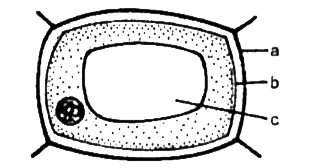
Give technical term for the condition of that cell in concentrated sugar solution.
View SolutionObserve the cell drawn and answer the following questions:

Define the process involved for shrinkage of b and c part.
View SolutionObserve the cell drawn and answer the following questions:
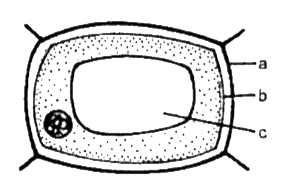
How can the cell be brought back to the condition of cell shown in the diagram?
View Solution
REVIEW QUESTIONS (Questions based on diagrams or set-up) questions and complete solutions for chapter TRANSPORT IN PLANTS of S CHAND BIOLOGY (ENGLISH) of Class 11
All Exercises from S CHAND Class 11 BIOLOGY TRANSPORT IN PLANTS
- NCERT EXERCISE WITH ANSWER
- NCERT EXERCISE WITH ANSWER (DIFFERNTIATE BETWEEN )
- REVIEW QUESTIONS (Differentiate between the following)
- REVIEW QUESTIONS (Fill in the blanks)
- REVIEW QUESTIONS (Give one word for the following)
- REVIEW QUESTIONS (Give reasons for the following)
- REVIEW QUESTIONS (Long answer type questions)
- REVIEW QUESTIONS (Miscellaneous questions with answers)
- REVIEW QUESTIONS (Multiple choice questions)
- REVIEW QUESTIONS (Questions based on diagrams or set-up)
- REVIEW QUESTIONS (Short answer type questions)
- REVIEW QUESTIONS (Very short answer type questions (with answers))
- TEST YOUR PROGRESS (Fill in the blanks with appropriate words )
- TEST YOUR PROGRESS (HIGHER ORDER THINKING SKILLS QUESTIONS (HOTS))
- TEST YOUR PROGRESS (OBJECTIVE TYPE QUESTIONS )
- TEST YOUR PROGRESS (SHORT/LONG ANSWER TYPE QUESTIONS)
- TEST YOUR PROGRESS (State whether the following statements are true or false)
- TEST YOUR PROGRESS (VERY SHORT ANSWER TYPE QUESTIONS)